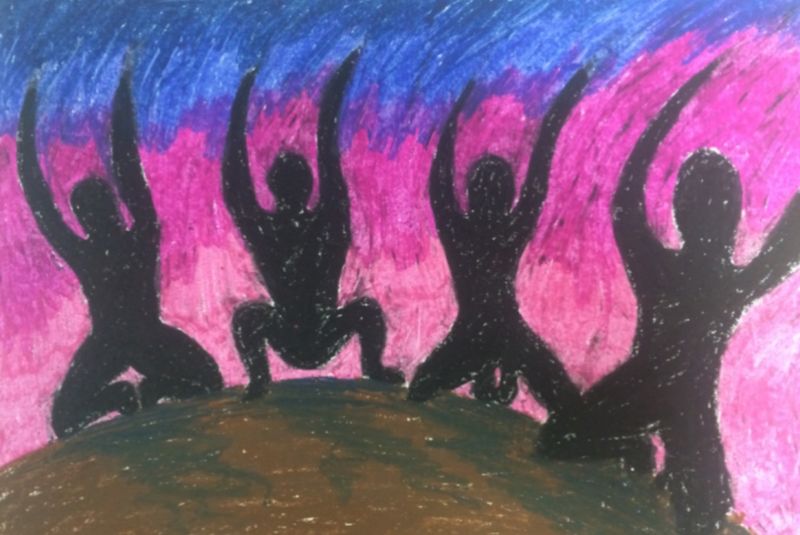Doors of perception –
Scientists at Imperial College London took EEG readings of subjects under the influence.

Enlarge/A sketch drawn by study participant of visuals during their experience.
People under the influence of a psychedelic brew known as ayahuasca frequently experience vivid visual and aural hallucinations and also report feeling as if they are in a dream. Nowa new studypublished in Scientific Reports has shown that the drug alters the user’s waking brain-wave patterns to produce a mental state that the researchers describe as “dreaming while awake.”
Ayahuasca is a bitter tea made from the Brazilian vinebanisteriopsis caapi, colloquially known as the “spirit vine,” used in shaman-led spiritual ceremonies among native people in the Amazon basin. Its primary active ingredient is dimethyltryptamine (DMT). That’s the secret to ayahuasca’s powerful psychedelic effects, which can also produce feelings of elation and fear or a sense of epiphany or psychological breakthrough. Those mind-altering properties come at a price, however. Participants in the ceremonies are often advised to bring a bucket, since nausea and vomiting (and sometimes diarrhea) are common reactions to the tea.
The brain controls perception and communication throughout the body via chemical neurotransmitters. Each neurotransmitter attaches to matching areas on nerve cells known as receptors. LSD, for example, targets the brain’s serotonin receptors. Ayahuasca contains a compound (banisterine) that latches onto dopamine receptors in the brain. (That’s why banisterine holds potential as a treatment for Parkinson’s disease, which destroys dopamine receptors.)

(Enlarge)/A healer starts a yage ceremony in Colombia. Yage is a mixture of the Ayahuasca hallucinogenic liana and a psychoactive bush.
Eitan Abramovich / AFP / Getty Images
Several prior brain-imaging studies involving humans have shown that psychedelics disrupt normal brain activity and boost the random firing of neurons in the visual cortex. For instance, a2012 studybyDavid Nuttand colleagues at the Imperial College London’s Center for Psychedelic Research (CPR) scanned the brains of 30 subjects (all experienced users of psychedelics) while under the influence ofpsilocybin– aka magic mushrooms. The lab then compared those scans to scans taken after the subjects ingested a saltwater placebo. The overall brain activity dropped in the so-called “default mode,” a collection of highly interconnected neuronal networks that typically fire together when the brain is at rest. Psilocybin disrupted that synchronization, which could cause the dissociative aspects — the oft-reported, disintegrating sense of self or ego — of hallucinogenic drugs.
In 2016, Nuttet al.published the resultsof a second fMRI study, this time with subjects under the influence of LSD, compared with a placebo. Once again, there was less synchronization (overall brain activity) among neurons in the default mode. But the researchers also found that certain disparate regions of the brain that normally didn’t communicate with each other did so under the influence of LSD, particularly the visual cortex. This could explain the vividly intricate hallucinations experienced by people tripping on acid. The effectappears to be separatefrom that of ego dissolution, however; It’s possible to experience one without the other.
Yetanother studythe following year in Scientific Reports found a sudden increase in randomness in brain activity in subjects under the influence of psychedelic drugs. This is possible evidence for a heightened state of consciousness commonly associated with psychedelics. And earlier this year, a team of Swiss researchers used MRI imaging to follow the brain under the influence of acid. The resultssupport the ideathat hallucinogens cause the breakdown of the system that helps the brain keep track of which information is coming from the real world and which is generated by the brain itself.
As Ars’ John Timmerreported in February, “Instead of a general flooding of the cortex, they found that a limited number of specific regions saw increased activity. This suggests the states induced by hallucinogens are distinct from states like anesthesia and sleep, which lead to widespread changes in the cortex. “
The current paper is the most recent study out of the Imperial’s CPR. The study involved 13 subjects fitted with EEG caps and electrodes to monitor their brain activity while being given an IV infusion of DMT. The team found that the DMT caused a marked drop in alpha waves, a mark of wakefulness, along with a corresponding brief increase in theta brain waves, indicative of a dream state.
-
These are brainwaves measured by EEG under control conditions.
-
These are brainwaves measured by EEG during DMT.
Furthermore, while brain activity has been shown to decrease in subjects under the influence of psilocybin and LSD, the Imperial College researchers found more chaotic brain activity in subjects while under the influence of DMT. That might be why ayahuasca users report more vivid visual effects and a greater sense of immersion than is typically experienced with other psychedelics.
“We saw an emergent rhythm that was present during the most intense part of the experience, suggesting an emerging order amidst the otherwise chaotic patterns of brain activity, “said lead author Christopher Timmermann. “From the altered brainwaves and participants’ reports, it’s clear these people are completely immersed in their experience — it’s like daydreaming only far more vivid and immersive, it’s like dreaming but with your eyes open.”
Future studies could involve extending the time subjects spend on DMT to gather even more brain wave data, or subjecting participants to fMRI imaging while on DMT, as has been done already with psilocybin and LSD.
“It’s hard to capture and communicate what it is like for people experiencing DMT but likening it to dreaming while awake or a near- death experience is useful, “said co-author and CPR head Robin Carhart-Harris. “Our sense is that research with DMT may yield important insights into the relationship between brain activity and consciousness, and this small study is a first step along that road.”
DOI: Scientific Reports, 2019.10 . 1038 / s 41598 – 019 – 51974 – 4(About DOIs).







GIPHY App Key not set. Please check settings